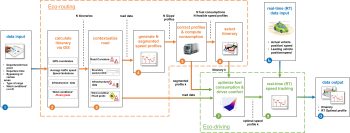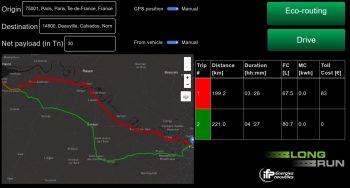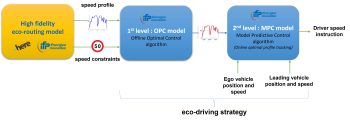IFP Energies Nouvelles (IFPEN) oversaw the development of connected strategies for heavy-duty vehicles aimed at enhancing the sustainability of transportation systems, with the main objective of minimizing energy consumption and CO2 and pollutant emissions. This includes eco-routing (ER) and eco-driving (ED) strategies, connected services that are hosted in a common cloud, and that they are accessible for the vehicle driver and operator via the existing telematics of vehicles.

Fig.1 Functional architecture of the ER and ED strategies
The services are also integrated into the multi scale simulation LONGRUN platform provided by Tecnalia to allow assessing their benefit through simulation. Connected services has proven to be highly effective in achieving fuel savings. In extensive testing, it has been demonstrated to guarantee fuel savings up to 7.1 %
The work concerning eco-routing and eco-driving does not depend on the outputs of previous LONGRUN deliverables but have either a starting point or are sharing common ground with other H2020 projects :
Eco-routing
ER strategies are planning processes that involve selecting the optimal path among all possible alternatives provided by the road network for a given vehicle and origin-to-destination coordinates (possibly including waypoints). This strategy is preliminary to the ED strategy. From a functional point of view, the input/output behaviour of the ER consists in translating different routing options provided by a Geographic Information System (GIS) into a speed profile that can be realistically tracked by the driver. This speed profile is representative of the route and physically feasible for the truck under consideration.
A driver centric (no destination) and destination-centered range predictor has been developed using the same energy consumption estimation that is used for eco-routing and a real-time estimation of the on-board energy, battery SoC and SoH. IFPEN, Tecnalia and VUB collaborate on this task. The predicted range can be proposed to the driver exploiting the OEMs Human-Machine Interface (HMI) or through a dedicated HMI.

IFPEN developed a dedicated HMI on a tablet, which has been integrated and tested on board of the demonstrator LONGRUN vehicles for a thermal heavy-duty vehicle (DAF truck) for night-time trips.
Read more about the developed HMI interface here
Eco-driving
Eco-driving is a strategy focused on the generation of suitable speed profiles that minimize an energy-consumption and driver comfort related cost. The input/output behaviour of the ED consists in generating a suitable speed profile that can be realistically tracked by the driver and minimizes a fuel consumption and driver comfort related cost.

The ED internally relies on a bi-level architecture, including an offline and an online optimal control level. The offline stage uses as input the realistic, driveable speed profiles generated for each segment by the ER algorithm and for the selected itinerary. The output of such a stage consists of a speed profile that serves as reference input for an online stage of the ED that, based on additional real-time input associated to the position of the leading vehicle, generates a modified profile that adapts to real-time traffic conditions.